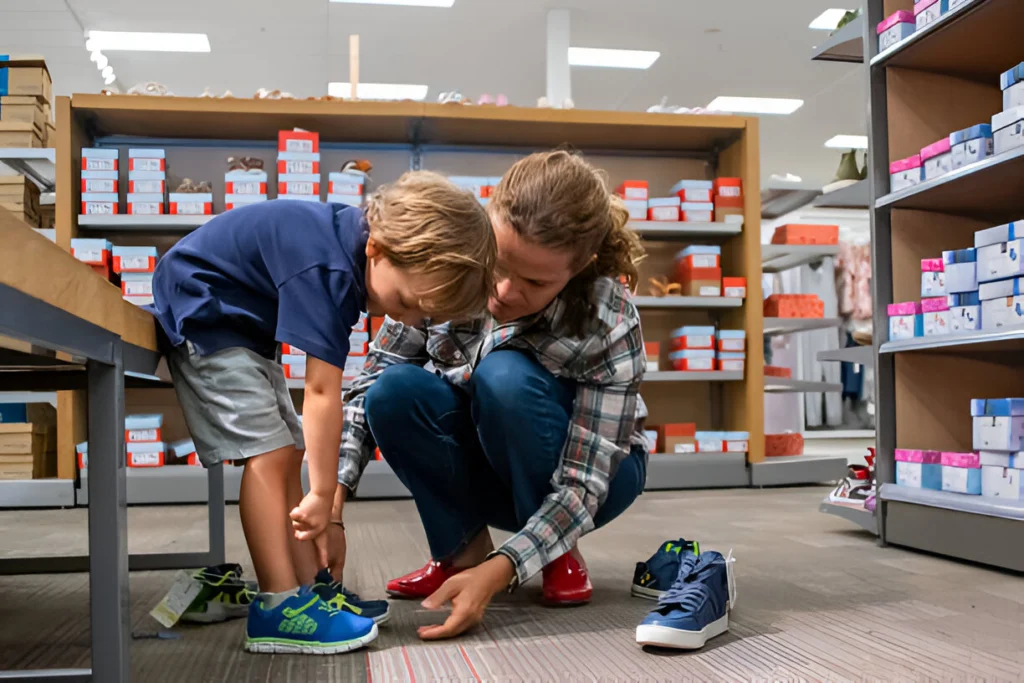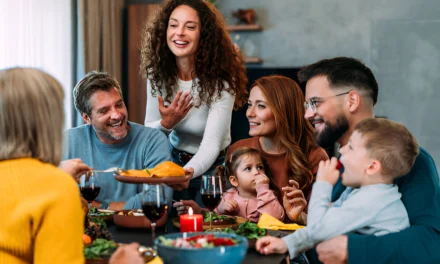As a parent, I’ve faced the challenge of grocery shopping with kids. It’s tough, especially with the temptation of sweets and the risk of meltdowns. But, grocery shopping can be fun and educational. With the right approach, it can become a special family activity.
Grocery shopping offers many chances for kids to learn. They can practice math and budgeting1. It’s also a chance for them to try new foods1. Plus, it helps with skills like working memory and planning1. Older kids can even make their own grocery lists1.
Shopping with kids isn’t always easy. The 3-year-old phase can make them feel insecure and act out2. But, with a few strategies, you can make every trip a positive experience for your family2.
Key Takeaways
- Grocery shopping with kids can be a fun, educational experience.
- It provides opportunities to teach math, budgeting, and other important skills.
- A proactive approach and the right strategies can lead to better cooperation and behavior.
- Consistency and repetition are key to establishing expectations and improving the shopping experience.
- Keeping kids engaged and entertained can make the trip more enjoyable for everyone.
Why Grocery Shopping with Kids is Beneficial
Shopping for groceries with your kids is a great learning experience. It teaches them math and budgeting skills. It also helps them learn new words and how to interact with others, even if they’re picky eaters.
Teaches Math and Budgeting Skills
Kids can count items and add up costs at the store3. They learn about budgeting and making smart choices. These skills are important for their financial future.
Builds Vocabulary and Social Skills
The supermarket is full of new words and chances to meet people4. Kids can learn about different foods and practice talking with others. These experiences help them grow in language and social skills.
Helps Picky Eaters Become More Familiar with New Foods
Shopping with kids introduces them to many foods, even if they’re hesitant at first3. By seeing and touching new foods, they become more willing to try them. This can lead to healthier eating habits for life.
While it may take longer, the benefits of grocery shopping with kids are worth it. It helps them develop skills and expands their food preferences. It’s a rewarding experience for the whole family.
Plan Ahead for a Successful Trip

Planning ahead is key for a stress-free grocery trip with kids. Choosing the right time and making a detailed list can make a big difference. It ensures a smoother trip5.
Choose the Time of Day Wisely
Timing is crucial when grocery shopping with kids. Pick a less busy time and when they’re not tired or hungry. This helps avoid meltdowns and makes the trip better6.
Make and Organize a List
Before you go, make a detailed grocery list. Order it by the store’s layout to save time and stress. It helps you remember everything and shop more efficiently6.
| Tip | Benefit |
|---|---|
| Choose a less busy time of day | Minimizes meltdowns and creates a more pleasant experience |
| Make a detailed, organized grocery list | Saves time and reduces stress, ensuring you don’t forget essential items |
By planning ahead and following these tips, you can have a successful grocery shopping trip with your kids56.
Prioritize and Shop the Perimeter
When you go grocery shopping with kids, start by focusing on what you really need. Shop the outer edges of the store first7. This way, you can get the important items even if your kids get upset.
The outer edges have the freshest and healthiest foods like fruits, dairy, meats, and seafood8. By choosing these first, you make sure your family eats well7. Many people, especially younger ones, prefer buying local and fresh7.
Shopping the outer edges also helps you avoid buying things you don’t need8. The longer you’re in the store, the more you might buy on impulse8. So, focusing on the basics saves you time and money.
Shopping smart and starting with the outer edges makes a big difference with kids. It helps you get what you need fast and makes shopping less stressful7. Next time, remember to shop the perimeter for a better trip.
Set Limits and Expectations
Before you go to the grocery store, it’s important to set clear limits and expectations with your kids. Tell them what behavior is expected and what will happen if they don’t follow it. This makes the trip smoother and less surprising9.
Try to avoid shopping when it’s really busy, like the day before holidays or on Sundays. Kids do better when they know what to expect9. Giving them tasks while you shop can also help. It makes them feel more involved9.
For young kids, consequences work best when they happen right after the misbehavior. It’s also key to follow through with rewards or consequences9. Planning and setting clear expectations can make the outing a success9.
“Setting limits and expectations helps create structure and prevents surprises during the grocery trip.”
| Tip | Benefit |
|---|---|
| Avoid peak shopping times | Children behave better with a clear plan |
| Assign tasks to children | Limits unwanted behaviors |
| Follow through with consequences | Vital for children’s learning |
Setting limits and expectations can make grocery shopping more fun for everyone9. A little planning can make a big difference in making the trip enjoyable.
Keep Kids Engaged and Entertained
Grocery shopping can be tough, especially with kids in tow. But, with a few smart moves, you can make it fun for everyone. Try bringing high-protein and fat snacks to avoid sugary cravings10.
Let Kids Help
Getting your kids involved in shopping can be a game-changer. Let them help with tasks like finding items or putting them in the cart. It keeps them busy and teaches them responsibility11.
Give Choices When Possible
Also, letting your kids choose things like a new fruit or veggie can make them excited. This simple act can cut down on tantrums by half11.
| Strategies to Keep Kids Engaged | Benefits |
|---|---|
| Bring Snacks | Avoid requests for sugary treats |
| Let Kids Help | Develop a sense of responsibility and investment |
| Give Choices | Reduce likelihood of meltdowns by up to 50% |
By using these easy tips, you can keep kids engaged during grocery shopping. It makes the trip better for the whole family1011.
Prepare for Meltdowns
Grocery shopping with kids can be tough, especially when they have a meltdown. But, with some preparation, you can handle these moments easily12.
Do a Test Run
Try a short trip to the store with your child first. This helps you see how they react and find what might upset them. Watching how they handle the store’s sights and sounds can teach you how to support them better12.
Praise Good Behavior
Always praise your child when they behave well. Positive words can encourage good actions. By celebrating their cooperation, you make shopping more fun for everyone12.
Have a Plan for Handling Meltdowns
Meltdowns can happen even when you’re ready. It’s key to have a plan for these times. Use “first/then” or “when/then” to calm things down. Stay calm and don’t fight back, as it can make things worse1213.
Remember, meltdowns are normal and don’t mean you’re a bad parent. By being ready and understanding, you can make a tough moment into a chance to learn together13.
Grocery Shopping
Grocery shopping with kids can be tough, but it can also be fun. Plan ahead, set clear expectations, and keep them interested. This way, grocery trips can be learning experiences for everyone.
Start by making a shopping list and organizing it by aisle. Choose a time when your kids are rested and fed to avoid tantrums14. Also, stick to a budget and track your spending to avoid overspending14.
At the store, focus on the perimeter for fresh foods. This helps you avoid buying too much. Set limits and expectations with your kids, like how many treats they can pick.
Bring snacks to keep hunger away and let kids help with tasks. Offer them choices, like picking between two healthy snacks14. If they get upset, stay calm and have a plan, like taking a break or leaving the store.
By using these tips, grocery shopping can be fun and educational for your family. Remember, a little prep and patience can turn a stressful task into a learning moment for your kids.
Shopping during off-peak hours can save you money by avoiding crowds and impulse buys14. Buying in bulk is also smart, but only if you’ll use everything to avoid waste14.
To save more, track your receipts and compare prices in a spreadsheet14. Using coupons and store specials can also cut down on grocery costs14.
Look for deals at different stores and try store brands for savings14. Frozen veggies are a cheap, nutritious option, just as good as fresh14.
By following these tips, you can save money and still get what your family needs. Remember, with some planning and creativity, grocery shopping can be a positive experience for everyone.
Target also offers a 100% satisfaction guarantee on its produce, with a money-back policy upon presenting a receipt15.
The Genius Sanity-Saving Tip
Grocery shopping with kids can be tough. But, there’s a smart tip to make it easier: avoid taking the kids into the store16. Use online grocery pickup services like Walmart+17 to skip the chaos.
Order online from home. Then, pick up your groceries without the kids. No more tantrums or arguing over what to buy17. You can also find great deals online16.
| Benefits of Online Grocery Pickup | Key Features |
|---|---|
| – Avoid the hassle of in-store shopping with kids – Save time and money with convenient delivery and deals – Skip long checkout lines and impulse buys | – Free same-day grocery delivery – No minimum order required – Contact-free checkout with mobile scan and go |
This tip is simple but genius. It lets you shop without distractions. You can make better choices and save money18. No more stress or tantrums, just a smooth shopping trip17.
Next time, try online grocery pickup. It could be the sanity-saving tip you need161718.
Walmart Online Grocery Pickup
Walmart’s online grocery pickup is a big help for busy parents. It lets you order groceries online and have them loaded into your car. This saves time and reduces stress. It also helps avoid the awkward moments that come with shopping with kids19.
Walmart Grocery offers delivery for a fee starting at $7.95. They also have a Delivery Unlimited service for free delivery. You can get a $10 promo code for future orders through their referral program19. And, Walmart+ members get free grocery delivery with no markups, as long as the order is $35 or more19.
Walmart’s online pickup service is all about saving time and hassle20. Just place your order online, and a personal shopper will load your items into your car. You can pick up your groceries from 7 AM to 11 PM, 7 days a week20.
Your order must be $35 or more to get free pickup. Otherwise, a $6.99 fee is added20. Walmart also guarantees the same prices online as in-store21.
Walmart’s online grocery pickup is a lifesaver for parents. It lets you skip the stress of shopping with kids. You can spend more time with your family instead19.
Planning and Focus are Key
When you go grocery shopping with kids, planning is key. Meal planning and making a detailed list before you go can help. It keeps you focused and avoids the stress of deciding what to buy on the spot22.
Know What You’re Going In To Purchase
Planning your grocery trip can change your experience. Meal planning leads to healthier eating and weight management22. It also makes shopping more purposeful22.
Knowing what you need before you shop helps you stay on track. It prevents impulse buys that might not fit your family’s needs or budget.
In the U.S., people spend about 46 minutes daily shopping for groceries23. Planning meals before shopping can cut down on time. It also ensures you don’t miss important items23.
Making a list helps you stay within budget and reduces food waste23.
Adding mindfulness to your shopping can make it better. Being present and non-judgmental can improve your experience22. Mindful eating can also help with weight and health22.
By focusing on planning, you can make grocery shopping more efficient and enjoyable. It aligns with your family’s needs2223.
Keep Kids Occupied
Grocery shopping with kids can be tough, but you can make it fun. Try playing I Spy as you walk through the aisles. Ask your kids to find certain items or colors24. It’s a great way to keep them busy and learn new things.
Give older kids a small shopping list to help you find things24. It’s a fun way to teach them about reading, organizing, and budgeting24. Many stores have special areas for kids, making shopping a fun family activity24.
For little ones, having special snacks can make a big difference25. Try reusable snack bags or toys like Melissa & Doug Water Wow Coloring Pads25. These small things can keep them happy and prevent tantrums25.
It’s important to find ways to keep kids engaged without too much screen time24. With a bit of planning, grocery shopping can become a fun learning experience for everyone.
Embrace Technology
When all else fails, consider the convenience of technology. Services like Walmart’s online grocery pickup let you order online. Then, a personal shopper loads your groceries into your car, skipping the store trip26.
Take Advantage of Technology
Technology can change your grocery shopping with kids. Did you know 33% of shoppers order groceries online weekly26? Also, 57% use digital tools to plan their trips26.
As tech grows, more shoppers use apps and smart carts for easier shopping. In fact, 63% use apps for in-store help, and 89% of Gen Zers do26.
Even though 56% still like in-store shopping26, the grocery world is getting tech-savvy. The smart cart market is set to hit $1.76 billion in 2023, growing 27.48% yearly26. Also, 34% prefer phone orders over laptops, and 15% have tried smart carts26.
Technology isn’t just for ordering and checkout. Stores are investing in tech to improve operations. They use data and AI to manage supply chains and personalize shopping27.
In-store tech, like smart shelves and digital signs, enhance shopping. They also give stores valuable data27.
The COVID-19 pandemic pushed online shopping forward. Stores now blend online and offline for a smooth experience27. Tech also helps manage the workforce, boosting productivity and happiness27.
So, don’t hesitate to use technology for better grocery shopping with kids. From online orders to smart carts, the future of shopping is tech-driven2627.
Bonus Tip
For an easier grocery shopping trip with kids, try to park as close as possible to the cart corral in the parking28. This simple trick can make the return to your car less stressful28.
Parking near the cart corral makes loading your cart easier. It’s great if you have a lot of groceries or if your kids are tired29. You can quickly get your family and purchases back home29.
Remember, parking close to the cart corral makes your trip easier. This bonus tip for grocery shopping with kids can greatly improve your experience2829.
Conclusion
Grocery shopping with kids can be tough, but it’s doable with the right approach30. Before COVID-19, many people liked going to the store more than shopping online30. But the pandemic made more people choose online shopping30. Now, people want to go back to shopping in person more than online30.
By planning, keeping kids involved, and using technology, you can make grocery trips better for everyone. This way, grocery shopping can be fun and less stressful for your family.
Grocery shopping is a common task in the US, with people going to stores about eight times a month31. But the competition is fierce, with thin profit margins due to inflation and supply chain issues31. As more people shop online, stores need to improve their online presence and offer better experiences31.
The secret to successful grocery shopping with kids is to plan well and stay focused32. Making a list helps you save time and money, and you’ll make healthier choices32. Engaging your kids and using technology can make grocery shopping a learning experience for everyone.






Thanks for your publication. One other thing is individual states have their own personal laws in which affect people, which makes it very, very hard for the the nation’s lawmakers to come up with a brand new set of guidelines concerning foreclosed on people. The problem is that a state has own legislation which may have impact in an unwanted manner on the subject of foreclosure policies.